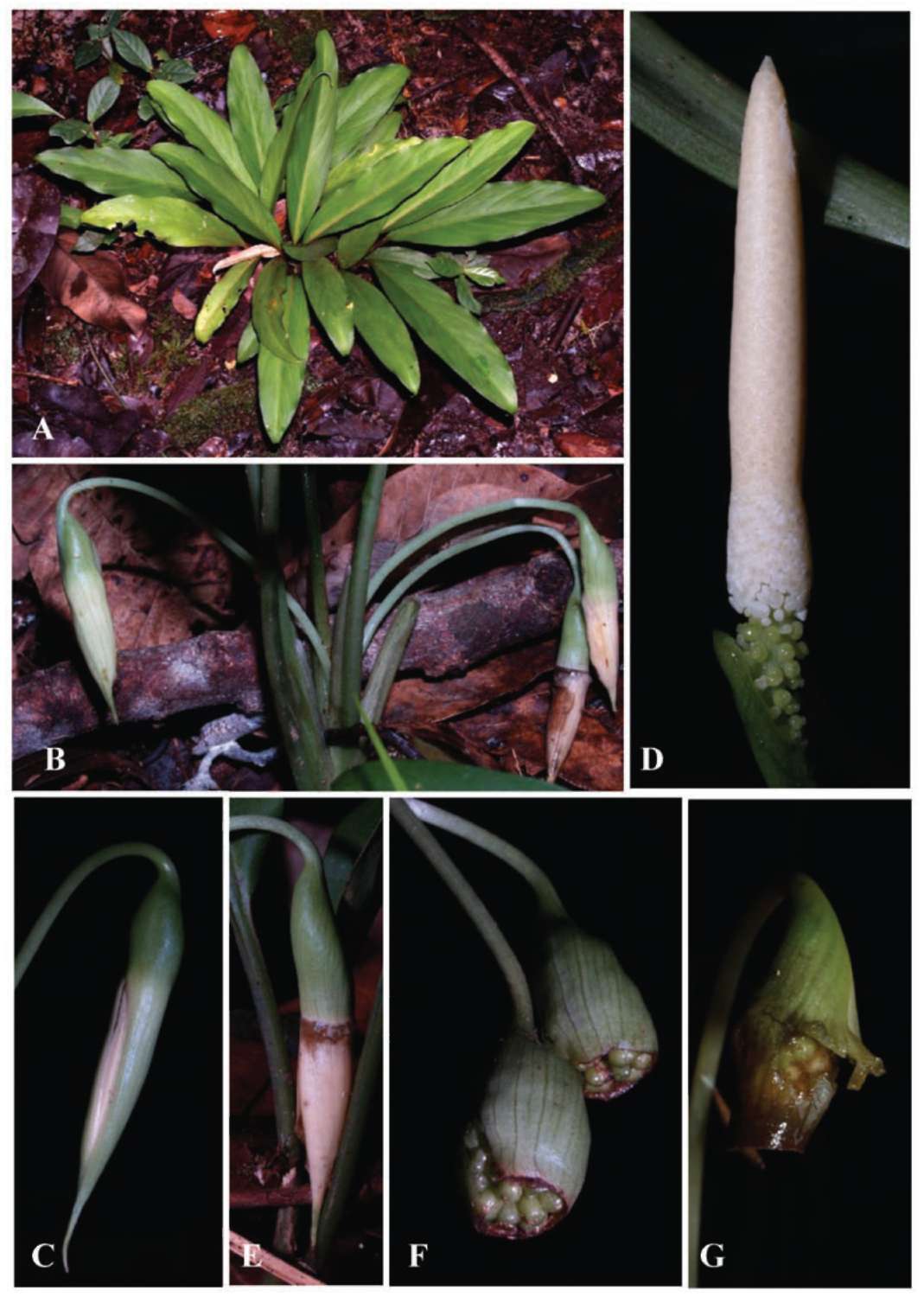|
|
oblonceolate, the base attenuate to narrowly rounded, the apex shortly acuminate and mucronate, the mucro solid; primary veins c. 6-8 per side, flush adaxially, barely prominent abaxially, interprimary veins irregularly present, secondary and tertiary venation inconspicuous and flush with the lamina. Inflorescences sequentially maturing synflorescence; peduncle very slender, wiry, suberect and elongating in fruit), inflorescence nodding from the apex of the peduncle; spathe narrowly cylindrical, long mucronate apically; lower spathe, narrowly ovoid, differentiated from spathe limb by a weak constriction; limb narrowly lanceolate, clasping and very slightly inflating and gaping at anthesis, thence deliquescent-deciduous; spadix equalling limb portion of spathe in length; female flower zone, adnate to the spathe; interpistillar staminodes few amongst the ovaries, mainly concentrated into a somewhat interrupted single row along the spathe/spadix adnation and another basally at the insertion of the spadix on the spathe/peduncle; pistils globose, rather distant; stigma button-like, sessile; ovules few on a basal placenta; interstice staminodes, slender-stalked, api-cally narrowly clavate, a little higher than the pistils; male flower zone cylindric; stamens close-packed, some with filaments partially united forming dimerous to trimerous male flowers, others solitary; anthers 士dumbbell-shaped from above with the connective forming a slight dome between the thecae; thecae opening through apical slit-like pores; pollen dusty; appendix tapering-cylindric to very narrowly ovoid, composed of very close-packed columnar flat-topped staminodes. Fruiting spathe narrowly campanulate, nodding, long-persistent, at fruit maturity deliquescing starting from the margin backwards towards the peduncle, and splitting longitudinally, fruits falling whole. Fruit ovoid-globose to somewhat compressed, ripening green, stigmatic remains dark brown. Seeds ellipsoid, strongly longitudinally ribbed, medium brown.
Distribution. MALESIA: disjunct between the Malay Peninsula, where it is known to only from Perak, and Borneo, where it is known from numerous but widely scattered localities in Sarawak and Brunei.
Habitat. In kerangas formations in lowland rain forest and lowland hill forest, and regrowth, always occurring on raised podsols in swampy areas, sometimes near streams to c. 250 m alt.
Notes. This is a very distinctive genus easily recognised by the rather numerous nodding inflorescences on relatively very long slender wiry peduncles. There is only a weak constriction present between the lower spathe and upper spathe and the orifice of the lower spathe is open during fruiting. The entire non-female portion of the spadix often dries and adheres to the spathe limb with the whole combined unit shedding.
Hestia longifolia has vegetative modules that readily disarticulate from the deep-seated rhizome. The function of the disarticulation in this podsol-obligated species is not clear, but it is speculated that it may be an adaption to fire resistance in a highly fire-prone habitat. Perhaps enabling the shoot unit to be destroyed in some way prevents
|
damage to the main perennating system.
Etymology. Hestia is named for the daughter of Cronus and Rhea, she was one of the twelve Olympians until replaced by Dionysus. Hestia was the Roman Goddess of the hearth and its fire, and was accorded special honour at feasts and sacrifices. She was also the Goddess of Chastity. The name is chosen in allusion to the fire-prone habitat of the single species, and the barely opening spathe.
Hestia longifolia (Ridl.) S.Y Wong & RC. Boyce, comb. nov.
Basionym: Schismatoglottis longifolia Ridl. J. Bot. 40: 37 (1902) Type: Malaysia, Perak, Bukit Larut, King's Collector 1967 (Lecto: K!, selected by Hay, in Sandakama 7 (1996) 26).
Specimens examined. MALAYSIA. PERAK: Tanjong Pondok, Burkill & Hanif 13246 (K, SING); Maxwell's Hill, Curtis 2082 (SINGT); Bukit Larut, Hay et al. 9063 (UPM); Taipmg Hill, Henderson 10253 (SING); Taipmg: along rd to Maxwell's Hill, Nicolson 1069 (SING); Kuala Temangoh, Ridley 14307 (SING); Gunung Hijau, Ridley s.n. (SING); 'Perak Hills', Ridley s.n. (K); Maxwell's Hill: Ridley s.n. (SING); Relau Tujor, Wray 1784 (CAL), 2193 (CAL, SING). SARAWAK: Kuching Division: just outside Kubah NP, above intake dam on Sg. Bungen, Boyce 770 (K); Bau, Kampung Grogo, 1 Mar 2004, P.C. Boyce & Jeland ak Kisai AR-233 (SAR); Bau, Kampung Grogo, 3 Jun 2004, PC. Boyce & Jeland ak Kisai AR-433 (SAR); Bau, Gunung Towai, 16 Oct 2004, PC. Boyce & Jipom ak Tisai AR-730 (SAR); Bau. Kampung Bogag, Gunung Tibugai, 01°21'31.1"; 110°03'48.7", 6 Jan 2005, P.C. Boyce & Jeland ak Kisai AR- 948 (SAR); Bau, Kampung Bogag, Gunung Tibugai, 01°21'31.1"; 110°03'48.7", 12 Jan 2005, PC. Boyce, R. Kneer & Jeland ak Kisai AR-960 (SAR); Bau, Kampung Grogog, 18 Jun 2005, PC. Boyce & Jeland ak Kisai AR-1239 (SAR); Bau, Krokong, Kampung Tringgus, Sungai Bong, 01°15'32.2"; 110°05, 27 Jun 2006, P.C. Boyce, Jeland ak Kisai & Wong Sin Yeng AR-1847 (SAR); Matang, Kubah National Park, Sg. Sen-duk trail, 01°37' 24.1"; 110°10'04.5", 4 Aug 2007, P.C. Boyce, Wong Sin Yeng & Simon Maclean AR-2133 (SAR); Bau, Bongo Range, trail to Tegora Mine, 01°19'41.5"; 110 °09'19.0", 8 Sep 2007, P.C. Boyce, Wong Sin Yeng & Alexander Kocyan AR-2192 (SAR); Serian, Brooke 9605 (L). Sarikei Division: Sarikei, Ulu Sarikei, Rumah Nyuka, 23 Oct 2006, P.C. Boyce & Wong Sin Yeng AR-2042 (SAR). Kapit Division: Belaga, km 10 Bakun - Bintulu-Miri road junction, 02°50'51.7"; 114°01'57.6", 11 Oct 2005, P.C. Boyce, Jeland ak Kisai & Jipom ak Tisai AR-1417 (SAR). Limbang Division: Limbang, Nanga Medamit, Mulu N.P., trail from Camp 5 to Kuala Terikan, 04°12'58.0"; 114° 53' 20.1", 29 Sep 2007, P.C. Boyce et al. AR-2227 (SAR); Limbang, Nanga Medamit, Mulu N.P., Sungai Abun Kiri, tributary from Sungai Terikan, from the back of Menta-wai Research Station, 04°14'07.4"; 114°52'27.6", 2 Oct 2007, P.C. Boyce et al. AR-2286 (SAR); Limbang, Nanga Medamit, Mulu N.P., trail from Kuala Terikan to Camp,
|
|
